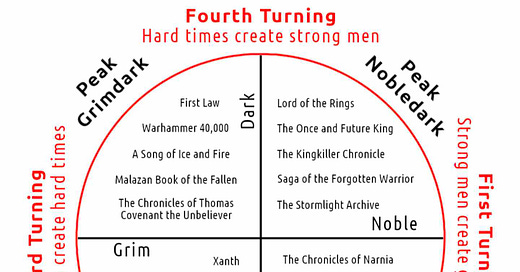What is grimdark fantasy?
In the book community the term “grimdark fantasy” is still new and rising. Authors, readers, and the industry alike all often mislabel books as grimdark when they don’t necessarily meet all of the requirements to be considered such. This mislabeling can readers disappointed in the books that they think will be dark while it might deter readers entirely who don’t understand what grimdark really is. Oh, and don’t get me started on the mislabeling of dark vs. grimdark fantasy. But, that’s not what this letter is about. This is about grimdark fantasy.
“Grimdark,” popularized by Warhammer 40,000 (Games Workshop), is a term used to describe speculative fiction that has a tone, style, or setting that is amoral or violent in nature. Since its birth into the universe, the term “grimdark fantasy” has been slapped onto popular novels such as Game of Thrones, First Law, and Malazan Book of the Fallen, etc. But, what do authors really mean when they label their books grimdark? Let’s take a deep dive.
The Subgenres
First, I find it important that we discuss what I only recently discovered: the intricate minute differences between grimdark, grimbright, nobledark, and noblebright.
There is a common agreement on research articles, traditional publishing houses, and grimdark fantasy authors on the following basic definitions of what each of these subgenres entail. Though again, I encourage you to do your own research as I am one human pulling together my thoughts. Here is the general agreed upon definitions:
Noblebright: A world in which good usually triumphs over evil, and the characters have the power to save the world. These stories focus on the fate of the world and result in the saving of the world by our main characters who are true heroes.
Grimbright: A world where good usually triumphs over evil, but the story does not focus on this aspect. Instead, the characters are preoccupied with smaller concerns in life and on their own personal quests that do not affect the fate of the world. The characters in this tale are still heroes though their success might be limited and temporary.
Grimdark: A world where morality is questioned and evil usually triumphs over good. The characters are either anti-heroes, unable to save the world/don’t want to save the world, or they fail to save the world/defeat the big evil.
Nobledark: A world where evil usually triumphs over good, but the characters have the power to change it and usually make an attempt to. This does not always result in a successful “saving of the world” ending.
The Grimdark Turning Wheel
So, what are some examples of books in each category of grimdark? I present to you The Grimdark Turning Wheel. I stumbled across this in my research, and I think it gives a really good example of how books in the genre are labeled and explored.
*Image above retrieved from an external source. It is NOT my own image.
Where do the books in Reveries fall?
Well, this is a little bit complicated to answer, isn’t it? On one hand answering based on the projection of a series might contain spoilers to the bleak reality of the worlds I’ve created. Then one must consider the implications labeling an entire universe, let alone multiverse, might entail. So, we shall talk briefly about each novel and then the series. BEWARE: knowing the genre might imply an ending you may not like!
Heir of Fates vs. The Shadow Sequence
The Shadow Sequence overall is grimdark fantasy. There is a darker tone, setting, and outcome to the series that leaves the world a worse place than we found it — or simply just the way we did find it. Without spoiling the ending, it was always my intention to explore not only morality but the theme “everyone is a villain in someone else’s story” with this series. That’s still my intention.
Each installment on its own might fall into a different category. You could make an argument that Heir of Fates alone is nobledark, and you could make an equal argument that Vessel of Shadows is too. After all, Silas and Nerisha are true heroes, and the majority of the cast want to save the world, albeit each in their own way. But, the overall projection of the series is that it will be grimdark. We just haven’t started chipping away at our heroes’ character arcs yet.
The Snow Thief’s Amulet
The Snow Thief’s Amulet is at its heart a romantic fantasy though in this regard, it being set in a grimdark multiverse, it is considered grimbright on this scale. Our heroes are preoccupied with their own quests and the story has no massive affect on the world post-Snow Thief.
Above the Oculus
Above the Oculus would be noblebright were it not set in the same world as Heir of Fates. It being a direct prequel to The Shadow Sequence sets it in a world where evil usually triumphs, firmly placing this novel in the nobledark category alongside fan-favorite, Lord of the Rings. I haven’t shared much about this novel publicly yet, but it focuses on the tale of how the Friary was created. Our main character is definitely a hero, but the world is darker than most would assume at first glance.
In conclusion: grimdark is new and complicated!
There are a lot of differing opinions and nuisances to the grimdark fantasy genre, but I hope this little bit of information clears up where I (and a lot of the industry) stand on this topic. It’s a newer genre, and we’re all still trying to figure out the defining features of each subgenre. Granted, subgenres can be very subjective to readers. Still, it helps to have a stepping stone when trying to define your dark book!
xx,
Rowan




